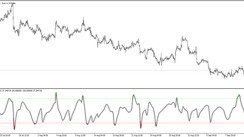Grasping the Essence of Fundamental Analysis
In the vast world of commodity trading, Fundamental analysis stands as a beacon of methodology. It serves as a pivotal tool for traders and analysts, aiding them in decoding the complexities of commodities. The heart of this methodology revolves around the dynamic principles of supply and demand, arguably the twin pillars underpinning the entire trading ecosystem.
On the surface, establishing a connection between the prices of commodities and the principles of supply and demand might appear straightforward. But, as many seasoned traders would attest, the art and science of projecting these relationships into future price movements can be intricate. Given the unique characteristics inherent to each commodity, crafting broad generalizations becomes a challenge in itself.
Unraveling the Cyclical Rhythms of Commodities
The realm of commodities is hallmarked by its cyclical nature. Commodities inherently follow a rhythmic pattern, governed by a combination of global events, market perceptions, and economic indicators. Periods arise when certain commodities, say gold or oil, see surges in demand. Such surges could be attributed to geopolitical tensions, economic booms, or even cultural trends, driving their prices upward. Conversely, there might be intervals characterized by an oversupply, pushing prices towards a downward spiral. Astute traders and analysts perpetually remain on the lookout for commodities hovering at multi-year peaks or troughs. Their rationale? Such extremities often herald the dawn of potentially rewarding trading opportunities.
Here's an elaborated version of the foundational equation posed by fundamental analysis:
- When Demand substantially outstrips Supply = Expect a bullish stance in Prices
- When Supply considerably eclipses Demand = Anticipate a bearish tilt in Prices
Pivotal Observations:
- Commodities dance to a rhythm of recurring cycles. The nuances of this dance are painted vividly by the fluctuations in supply and demand, which, in turn, orchestrate the commodity's price movements.
- A market scenario where demand reigns supreme over supply almost always catalyzes an upswing in prices.
- Conversely, when supply engulfs demand, prices invariably tread a declining trajectory.
- The savviest commodity traders employ a dual-pronged strategy. They harness fundamental analysis to glean overarching market narratives and then seamlessly weave in technical analysis to calibrate their market forays—both entries and exits.
Delving into the Nuances of Commodity Supply
Discussing the supply of commodities requires one to envision a holistic picture. This picture melds the quantum of a commodity produced during the current year with the reserves, or stockpiles, left over from preceding years. Consider soybeans. Their supply would encapsulate both the crops being nurtured in the present year and remnants from past harvests. An empirical trend that emerges time and again: a sizable stockpile from yesteryears often correlates with muted prices in the market.
Commodity supply isn't just about numbers—it's a narrative shaped by a constellation of factors. Elements like unpredictable climatic shifts, geopolitical decisions determining land allocations for cultivation, unforeseen interruptions in production, the outbreak of crop diseases, and rapid technological advancements—all these play pivotal roles. A cornerstone principle of fundamental analysis postulates that soaring commodity prices typically magnetize an upsurge in production. This is the basic law of economic attraction: heightened prices promise lucrative returns, making the prospect of production more appealing. Yet, this isn't a linear relationship. An exorbitant hike in prices might alienate consumers, leading to dampened demand. And if this curtailment in demand becomes too pronounced, the very price surge could be its undoing.
Unpacking the Dynamics of Commodity Demand
When we touch upon demand in the lexicon of commodities, we're essentially capturing the consumption patterns evident at extant price tiers. A foundational belief, corroborated by decades of market observation, asserts that a contraction in commodity prices invariably rejuvenates demand. Conversely, skyrocketing prices can act as deterrents, tempering the enthusiasm of consumers. An enduring aphorism, "low prices cure low prices," underscores this sentiment, emphasizing that plummeting prices invigorate consumption patterns. Such revitalized consumption, over time, diminishes supply reserves, setting the stage for a future resurgence in prices.
Drawing parallels with everyday life often illuminates complex concepts. Take the instance of gasoline. It's intuitive that at a palatable price point of $1.50 per gallon, one would be more inclined to traverse longer distances, thereby consuming more gasoline. But, if this price were to double to $3.00 per gallon, caution might prevail, leading to moderated consumption. This analogy underscores the intricate balance governing commodity economics—showcasing how consumption behaviors fluidly adapt in response to price shifts.
Leveraging Fundamental Analysis to Foresee Price Trajectories
While fundamental analysis offers a robust framework, using it to prognosticate short-term price fluctuations in commodities is akin to navigating a labyrinth. New entrants to the commodity trading arena often find themselves grappling with this complexity. Hence, an overarching strategy, rooted in long-term perspectives, emerges as the recommended approach for both greenhorns and seasoned traders. The quest is to identify and understand underlying trends that signify impending tectonic shifts in the supply and demand landscape.
Initiating this analytical journey mandates immersing oneself in a sea of reports. These reports, often rich in insights, are curated by esteemed bodies such as the USDA, Department of Energy, and Futures Exchanges. Additionally, premier commodity brokerage firms often provide their clientele with meticulously crafted fundamental research reports, further aiding their decision-making processes.
While the allure of synthesizing all this data to foretell future supply and demand scenarios is tempting, it's also Herculean. Especially when one considers the might of industry behemoths, who possess deeper data reserves and unparalleled analytical acumen.
Navigating the Oceans of Market Trends
For a trader or an analyst, the endgame is clear: decipher market trends and align strategies accordingly. If, for instance, indicators hint at a burgeoning supply of corn and concurrent data points towards record plantation figures for the current season, an intuitive inference would tilt towards a bearish outlook for corn futures. Such insights could guide traders towards crafting short-sided strategies.
Yet, markets are living entities, teeming with unpredictability. A sudden, steep price decline might rekindle consumer interest. Or, unforeseen climatic adversities might cripple production. Thus, a trader's toolkit must be imbued with adaptability and resilience.
While fundamental analysis paints the broad strokes of the market canvas, the finer details often demand another ally—technical analysis. By harmoniously integrating these two, traders can achieve a holistic market view. This seamless amalgamation of broad insights from fundamental analysis, coupled with the granular precision of technical analysis, forms the bedrock of the Techno-Fundamental approach—a philosophy many market maestros swear by.





